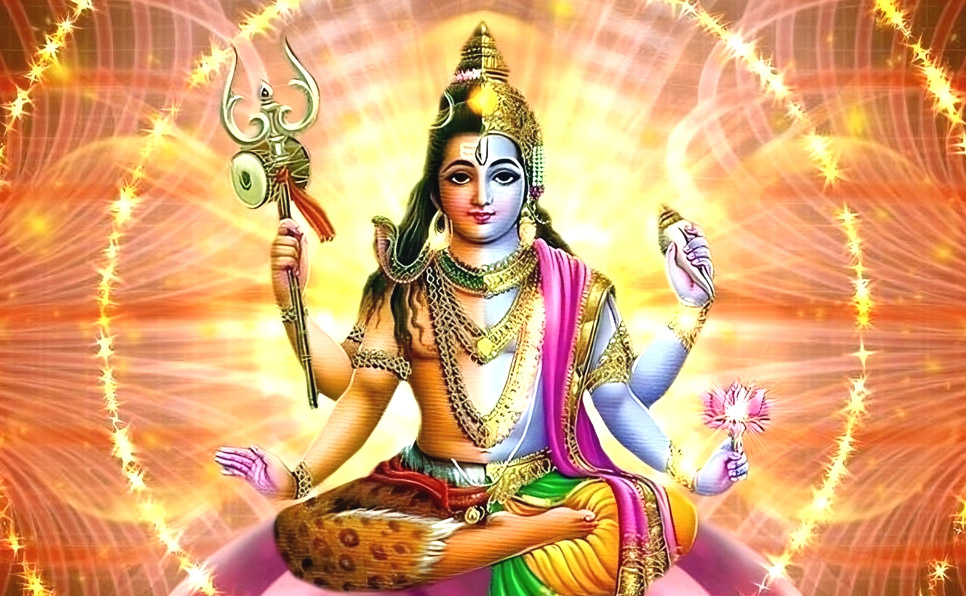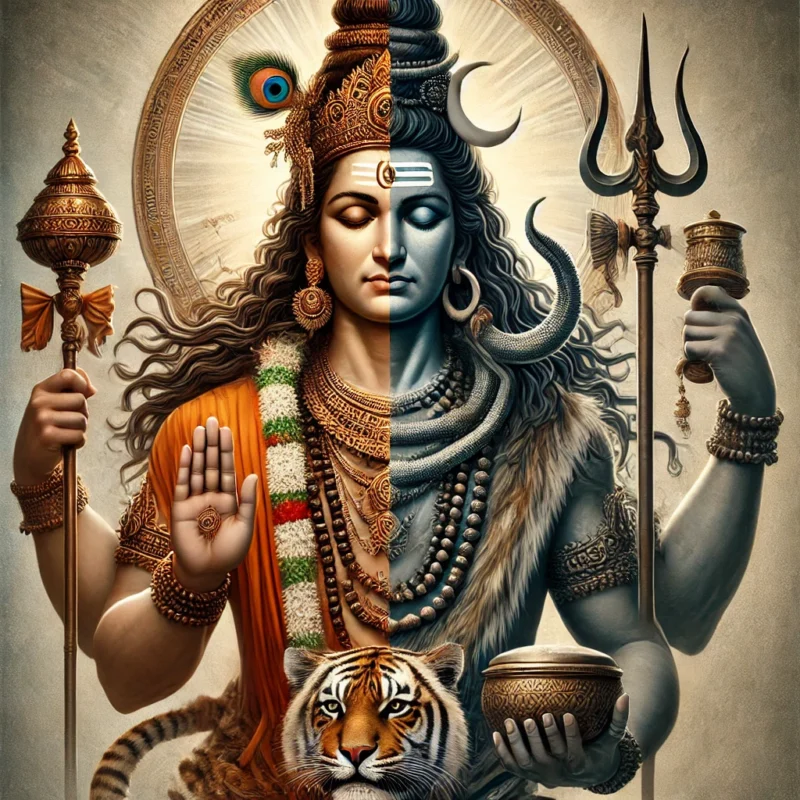Harihar is a form of composite deity in Hinduism that combines aspects of the two major gods, Vishnu (Hari) and Shiva (Hara). The name “Harihar” is a combination of “Hari,” a name for Vishnu, and “Hara,” a name for Shiva.
This unified form represents the synthesis of these two major deities, emphasizing their intrinsic unity and the non-dual nature of ultimate reality. Harihar is also known as Shankaranarayana (where “Shankara” is Shiva and “Narayana” is Vishnu).
Hinduism’s diversity encourages various beliefs and traditions, with two significant and large traditions relating to Vishnu and Shiva. Some sects regard Vishnu (and his avatars such as Rama and Krishna) as the supreme god, while others consider Shiva (and his various avatars like Mahadeva and Pashupati) as supreme.
The Puranas and various Hindu traditions consider both Shiva and Vishnu as different forms of the same Brahman. Harihar symbolically represents this idea.
Table of Contents
The Origin Story of Harihar
The origin of Harihar can be understood through a folk tale. Once, Daksha, the son of Brahma, who was born from his right thumb, organized a great yajna (sacrifice). He invited everyone to this yajna.
The Saptarishis (seven sages) also attended the yajna and began chanting Vedic mantras loudly. It is said that the sound of these mantras was so loud that it echoed throughout the universe. Lord Shiva, who was meditating on Mount Kailash, got disturbed because of this loud chanting.
The sounds were so intense that it broke Shiva’s meditation. Angered, Shiva went to the place where Daksha was performing the yajna and destroyed it in his fury. Due to Shiva’s anger, Daksha and the Saptarishis, along with other gods, fled from there, but Lord Vishnu, the preserver of the universe, stood against it. Vishnu argued that the yajna was essential for the sustenance of the gods, who in turn maintain their grace upon humans. If the yajna was disrupted, it would upset the balance of the universe. It is said that a battle ensued between Shiva and Vishnu. Their fight shook the entire universe.
Brahma, frightened by this, intervened because the creation was still in its early stages, and this battle threatened its very existence. Brahma told both Shiva and Vishnu that they were equal and complementary to each other, with neither being superior or inferior. Thus, their battle would never have a victor or a loser and would continue indefinitely without resolution, but it would certainly destroy the universe, which was not yet fully formed. He urged them to either end the battle immediately or destroy the universe right away. Shiva and Vishnu understood Brahma’s reasoning and ceased their battle.
Brahma then said that since they ended the battle and relieved his distress, Vishnu would henceforth be known as Hari, and Shiva as Hara. Together, they would be called Harihar, meaning the remover of devotees’ sorrows and pains. Hence, we see Lord Narayana referred to as Hari Vishnu, and Lord Shiva as Har Har Bhole or Har Har Mahadev.
Form of Harihar Deity

In the form of Harihar, Shiva is typically depicted on the left side and Vishnu on the right. However, there are images where Shiva is on the right and Vishnu on the left, indicating a lack of uniformity in these representations. Shiva is shown holding a trident (trishula), while Vishnu is depicted holding a discus (sudarshana chakra) and a conch (shankha). In some rare images, Vishnu is shown holding a mace (gada) and Shiva holding a drum (damaru). Some sculptures also depict Shiva with a third eye.
According to Swami Sivananda, Lord Shiva and Lord Vishnu are actually one. They are different aspects of the omnipresent Supreme Being or Parabrahman. There is this popular shloka indicating the same;
“Shivasya Hridayam Vishnu, Vishnoscha Hridayam Shiva.” Vishnu is the heart of Shiva, and likewise, Shiva is the heart of Vishnu.
Similarly, another famous shloka is: “Shivaya Vishnu Roopaya, Vishnave Shiva Roopine.” This also signifies that Shiva and Vishnu are one.
Shiva and Vishnu have always respected each other
How beautifully these two gods complement each other and respect each other can be inferred from the stories of Ramayana and ShreemadBhagvadPuran where we see that Lord Shiva in the form of Hanuman helped Ram: in fighting against the demons and freeing Ram’s wife from Ravana’s capture. Similarly, we see how Hanuman also came to help Krishna and Arjun during the battle of Mahabharata between the Pandavas and Kauravas.
There is one more story mentioned in Shree Ramcharitmanas. Before the starting of the war with Ravana’s army and before Ram’s army build the bridge over the sea, Lord Ram build a Shivalinga near the coast of sea to seek the blessings of Lord Shiva. Today we know that Shivalinga by the name of Rameshwaram and it is one of the 12 jyotirlingas in India.
According to the literatures of the Tretayuga, once when Lord Krishna was in his infant state, Lord Shiva felt like seeing his child form. He came to Vrindavan disguised as a monk to see him and asked Yashoda Maiya to let him see her son, but frightened Yashoda Maa refused him. Lord Shankar got very upset, and he started pleading Lord Vishnu that O Lord, in any way kindly persuade your mother that she allows me to see you or create any other illusion, but I’ll not return to Kailash without seeing you. Upon this Lord Vishnu created maya (illusion) so that Lord Shankar can please himself with Shree Krishna’s infant form.
Similarly, there is also an incident that once Lord Shiva took the form of a lady (gopi) so that he can participate in the group dance (raas leela) which Lord Shri Krishna used to do with the gopis (women) of Vrindavana. Infact there is one very famous Shiva temple in Vrindavan as well called Gopeshwar mahadev dedicated to the gopi form of Lord Shiva.
The Harihar form of Lord Shiva shows the unity of two great powers, Lord Vishnu and Lord Shiva. It teaches us that creation, preservation, and change are all connected and work together for the balance of the world. This form reminds us to live with harmony and see everything as part of one divine energy. By worshipping Harihar, we can learn to live with peace, understanding, and devotion in our daily lives.
If you are looking to buy incense or other puja products such as havan cups or cow desi ghee diyas, consider buying our authentic products from here.







